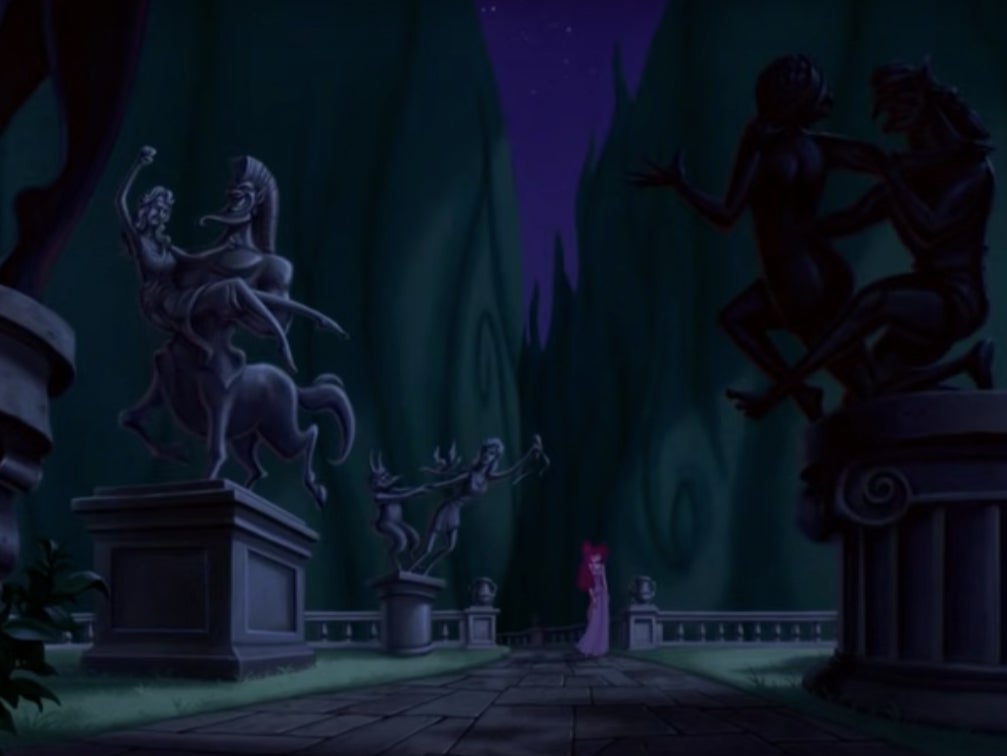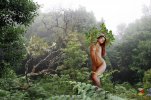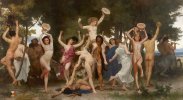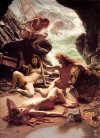 The Cave of the Storm Nymphs
The Cave of the Storm Nymphs is a painting by British artist Edward Poynter, depicting three nude sirens or nymphs from Greek mythology that lure sailors to their deaths. There are two versions, with minor differences, dated 1902 and 1903.
In Greek mythology nymphs were beautiful maidens as well as minor deities, associated with a particular place such as a fountain or river or forest. The nymphs in Poynter's painting would be Nereids, or sea nymphs. Humans could on occasion catch of glimpse of nymphs, dancing or bathing in a stream or pool. Such encounters could cause dumbness, besotted infatuation, or madness for the unfortunate watcher.
Sirens on the other hand, originally half bird and half woman, and later assimilated to mermaids, were dangerous creatures who lured sailors with their enchanting music and sweet voices to shipwreck on the rocky coast of their island.
Poynter's figures appear to partake in both categories. One of them is playing music on an instrument made from a shell, having no doubt lured the ship caught in a storm to the rocky coast. The other two creatures are playfully and lasciviously enjoying the wealth brought to them by the shipwrecks.
Alice on the other hand looks thoughtful, or sad. Lost in her own thoughts, oblivious of the world and sitting in an immodest pose, is she perhaps mourning the death of a handsome young sailor she was unable to save from drowning ?
It seems that no sooner have I commented on my last Alice picture (
'Reindeer Syndrome') about sources from her 'Shelter' series being rarely used in manipulations, than Kam identifies a pose from that very same series for blending into a new version of Sir Edward Poynter's famous painting.
'The Cave of the Storm Nymphs' has long been a favourite of mine, combining the genres of maritime painting and the female nude in a scene filled with awesome beauty and dramatic tension.
Elsewhere, I have been discussing Alice's portrayal of the
femme fatale in recent works by
@wikk and
@Wragg , and this association is confirmed in the role provided here by Kam. Poynter's nymphs are as ambiguous as they are mysterious, assuming the qualities of both nymphs and sirens, a blend of types quite capable of luring a sailor for his pleasure as an alternative to his doom. Certain aspects and influences of the original painting were previously explored in Wragg's thread, 'Fit, Lovely Ladies Crucified' -
At the time that he was working on the painting, Poynter was a highly acclaimed artist at the height of his career, also being the Director of London's National Gallery and President of the Royal Academy. Whilst this particular work has provided inspiration for my own painting, Kam's introduction of Alice anticipates her impending role as a sirenesque character in an embryonic Bobinder project - a coincidence which is altogether remarkably prophetic.
I am pleased to see that Kam was able to work on a large scale for this manipulation. The painting is highly detailed, and justifies a large reproduction. Indeed, Kam has paid close attention to detail in terms of the scale, colour saturation and lighting of the new figure, and I am delighted to find my favourite muse so beautifully blended into one of my favourite paintings. The semi-reclining pose is perfect, and the melancholy expression seems to inspire the consolation of the painted figure beside her.
The overall effect produces a subtle, sensitive and sympathetic modification of the original composition. Poynter's figures lead the eye through a gentle curve up and down the picture, from upper middle distance to foreground, and back again. The compositional flow still works with Alice occupying the inside of the curve, although she now provides an alternative route for the eye to follow.

The source was photographed in bright sunlight at a wooden snow shelter on Ay Petri, and Kam has effectively reinterpreted these lighting conditions to complement the combination of backlighting and ambient light in the painting. This has been achieved by making colour and contrast adjustments to emulate the golden skin tones of the painted figures. The effect becomes more convincing once we observe the new shadows, carefully applied beneath Alice's legs. Equally important to the blending process is the use of a noise filter treatment which gives Alice's skin a vibrance and texture which approximates the influence of the woven canvas texture on the painted figures.
Kam's work also scores highly in terms of character interaction. Poynter depicted his nymph tossing a handful of gold coins in the air. The pile of coins is visible beside Alice's left leg, and now the nymph is caressing her hair. The airborne coins become slightly incongruous, but these are small details. Existing features are employed to disguise the fact that Alice's fingertips and toes are cropped out of her source photograph. And so her right foot disappears behind a pile of sea shells, and her left fingers are partly concealed behind her friend. Her right hand is visible in the source photo, between the buttocks and heels, but Kam has elected to delete this, and the hand is assumed to occupy a different position, somewhere out of sight.
Whilst Alice delivers the lascivious pose required by Valery Anzilov's erotic remit for Femjoy, her relaxed expression appears natural, suggesting some slight discomfort. This is consistent with the cold, breezy conditions on the exposed mountainside, which have produced goose bumps all over the model's skin, and particularly on her breasts. I tend to indulge most of the available opportunities to talk about Alice, and indeed Kam has employed her in some very original ways to date, but I hope the background detail helps to illustrate the high quality of the manipulator's work on this occasion. This is absolutely one of your finest interpretations, Kam.















